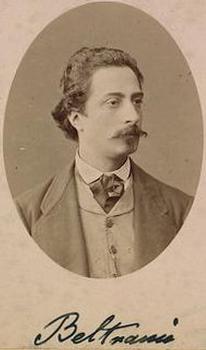Italian mathematician
Biographical Information
| Name: | Eugenio Beltrami |
|---|---|
| Born on | 16 November 1835 in Cremona, Cremona, Lombardy, Italy, Europe |
| Deceased on | 18 February 1900 in Rome, Roma, Lazio, Italy, Europe |
Short biography of Eugenio Beltrami
Eugenio Beltrami was born into a family of artists. His father was a respectable painter of miniatures who as a result of political turmoil emigrated to Paris in 1848 where he became the curator of an art gallery. Eugenio Beltrami began studying mathematics at the University of Pavia, but had to interrupt his studies for financial reasons and took a job in the offices of the Lombardy– Venice Railway. At the age of 25 he was able to resume his studies, guided by the very assured advice of Francesco Brioschi (1824–97). Beltrami published his first mathematics paper in 1861 and others followed in quick succession. By 1862 he was able to resign from his job in the railway offices and at the age of 27 was appointed associate professor of algebra and analytical geometry at the University of Bologna. “From then on, his life was cheerful and relaxed, dedicated exclusively to caring for his family, his students and his favourite studies” [Pascal, 1903, p. 67]. That energetic and untiring promoter of young scholars, Enrico Betti, was responsible for Beltrami’s appointment as professor at the University of Pisa, where Cremona was one of his colleagues and where he worked as a teacher and researcher from 1863 to 1866; thereafter, he moved back to the University of Bologna to take up a post as professor of theoretical mechanics until 1873. After Rome had become the capital of Italy in 1870, a plan was drafted to establish the largest university in the kingdom there staffed by the best scientists. And that is what happened. World-famous thanks to his contributions to differential geometry, Beltrami was also invited to join the new university in Rome. Between 1873 and 1876, he lectured on the wide-ranging field of theoretical mechanics and higher analysis. During those years he drifted further and further away from his original areas of research and turned more and more to mathematical physics, which resulted in him being appointed professor for this subject at the University of Pavia, where he worked extremely successfully until 1891. During this second period of creativity, “he went through almost all the fields of mathematical physics in a series of 60 treatises: electricity, magnetism, potential theory, light, heat and elasticity” [Pascal, 1903, pp. 68–69]. In four treatises Beltrami managed to establish the mathematical foundations of linear elastic theory, in the forefront of which stands the tensorial differential equation named after him and John Henry Michell. Beltrami returned to the University of Rome in 1891, “where they had been trying to get him to return for some time; and it was a Rome that he died on 18 February 1900, just as he had lived – with the cheerful composure of an ancient philosopher” [Pascal, 1903, p. 69].
Main contributions to structural analysis:
Sulle equazioni generali dell’elasticità [1881]; Sulle condizioni di resistenzia die corpi elastici [1885]; Sull’interpretazione meccanica delle formole di Maxwell [1886]; Note fisico-matematiche (2a parte) [1889/1]; Sur la théorie de la déformation infiniment petite d’un milieu [1889/2]; Opere matematiche [1902–20]
Source: Kurrer, Karl-Eugen The History of the Theory of Structures, Wilhelm Ernst & Sohn Verlag für Architektur und technische Wissenschaften GmbH, Berlin (Deutschland), ISBN 3-433-01838-3, 2008; p. 715-716
Relevant Publications
- (2008): The History of the Theory of Structures. From Arch Analysis to Computational Mechanics. 1st edition, Wilhelm Ernst & Sohn Verlag für Architektur und technische Wissenschaften GmbH, Berlin (Germany), ISBN 978-3-433-01838-5, pp. 715-716.
- (2018): The History of the Theory of Structures. Searching for Equilibrium. 2nd edition, Wilhelm Ernst & Sohn Verlag für technische Wissenschaften, Berlin (Germany), ISBN 978-3-433-03229-9, pp. 968.
- About this
data sheet - Person-ID
1009692 - Published on:
19/04/2013 - Last updated on:
22/07/2014




